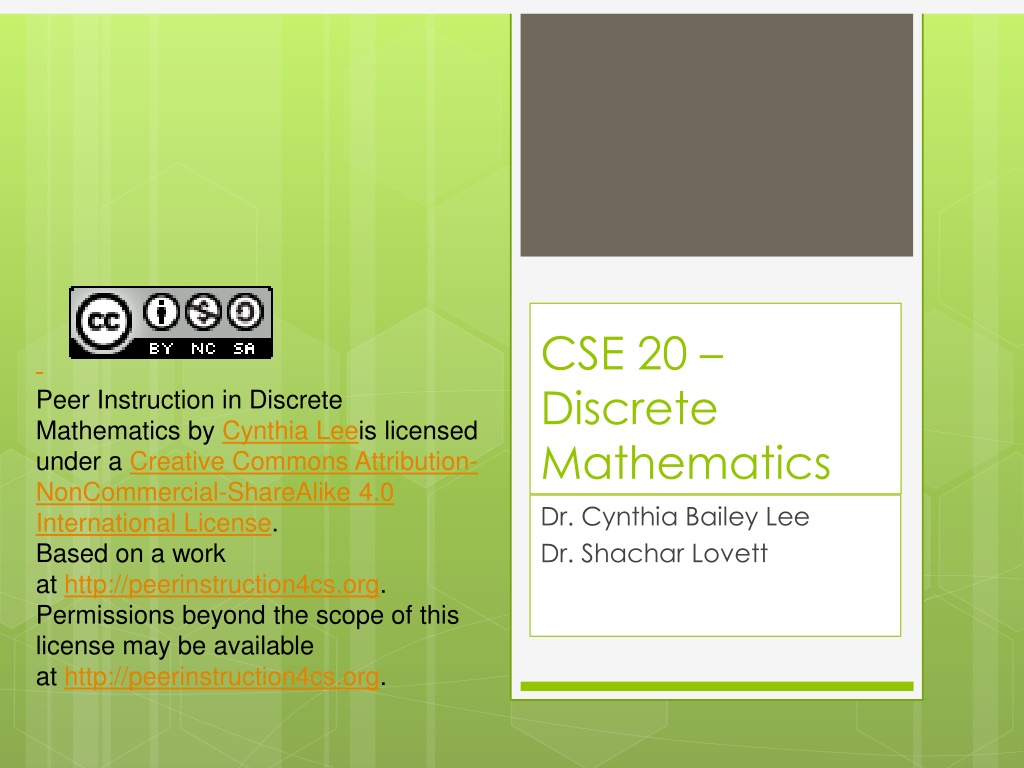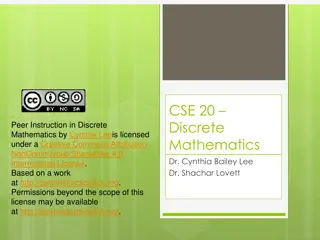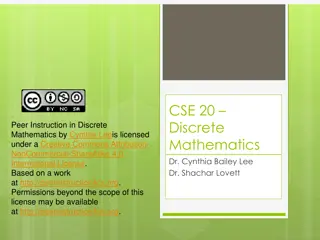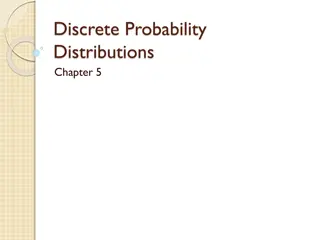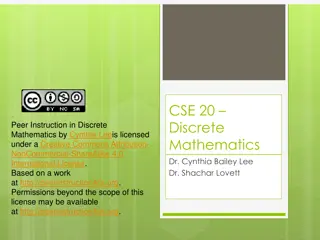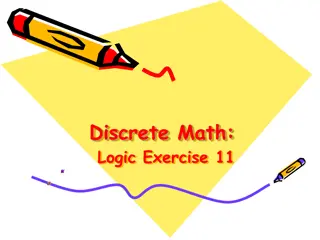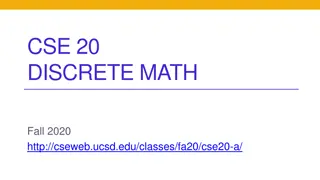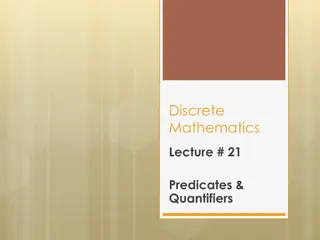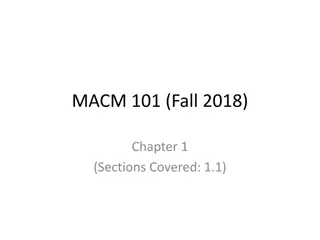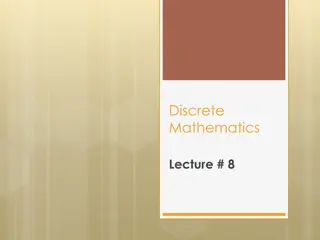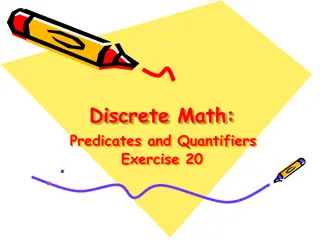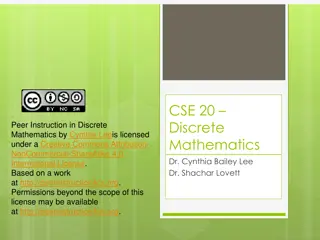Understanding Functions in Discrete Mathematics
Explore the concept of functions in discrete mathematics through a series of engaging slides covering topics such as function definitions, injectivity, surjectivity, and bijectivity. Delve into the fundamental principles of mapping elements and identifying different types of functions within sets X and Y.
Uploaded on Oct 10, 2024 | 0 Views
Download Presentation

Please find below an Image/Link to download the presentation.
The content on the website is provided AS IS for your information and personal use only. It may not be sold, licensed, or shared on other websites without obtaining consent from the author. Download presentation by click this link. If you encounter any issues during the download, it is possible that the publisher has removed the file from their server.
E N D
Presentation Transcript
Creative Commons License CSE 20 Discrete Mathematics Dr. Cynthia Bailey Lee Dr. Shachar Lovett Peer Instruction in Discrete Mathematics by Cynthia Leeis licensed under a Creative Commons Attribution- NonCommercial-ShareAlike 4.0 International License. Based on a work at http://peerinstruction4cs.org. Permissions beyond the scope of this license may be available at http://peerinstruction4cs.org.
2 Today s Topics: 1. Functions 2. Set sizes 3. Infinite set sizes (if time permits)
3 1. Functions
4 What is a function? Is the following a function from X to Y? A. Yes B. No X Y
5 What is a function? Is the following a function from X to Y? A. Yes B. No X Y
6 What is a function? Is the following a function from X to Y? A. Yes B. No X Y
7 What is a function? Is the following a function from X to Y? Y A. Yes B. No X
8 What is a function? Is the following a function from Y to X? Y A. Yes B. No X
9 What is a function A function f:X Y maps any element of X to an element of Y Every element of X is mapped f(x) is always defined Every element of X is mapped to just one value in Y
10 Injective, Surjective, Bijective Is the following function A. Injective B. Surjective C. Bijective D. None X Y
11 Injective, Surjective, Bijective Is the following function A. Injective B. Surjective C. Bijective D. None X Y
12 Injective, Surjective, Bijective Is the following function A. Injective B. Surjective C. Bijective D. None X Y
13 Injective, Surjective, Bijective Function f:X Y f is injective if: f(x)=f(y) x=y That is, no two elements in X are mapped to the same value f is surjective if: y Y x X s.t. f(x)=y There is always an inverse Could be more than one x! f is bijective if it is both injective and surjective
14 2. Set sizes
15 Set sizes Let X,Y be finite sets, f:X Y a function Theorem: If f is injective then |X| |Y|. Try and prove yourself first
16 Set sizes Let X,Y be finite sets, f:X Y a function Theorem: If f is injective then |X| |Y|. Proof by picture (not really a proof, just for intuition): X Y
17 Set sizes Let X,Y be finite sets, f:X Y a function Theorem: If f is injective then |X| |Y|. Proof: Consider the set S={(x,f(x)): x X}. Since f is a function, each x X appears exactly once hence |S|=|X|. Since f is injective, the values of f(x) are all distinct, i.e. each value y Y appears in at most one pair. Hence |S| |Y|. So, |X| |Y|. QED.
18 Set sizes Let X,Y be finite sets, f:X Y a function Theorem: If f is surjective then |X| |Y|. Try and prove yourself first
19 Set sizes Let X,Y be finite sets, f:X Y a function Theorem: If f is surjective then |X| |Y|. Proof by picture (not really a proof, just for intuition): X Y
20 Set sizes Let X,Y be finite sets, f:X Y a function Theorem: If f is surjective then |X| |Y|. Proof: Consider the set S={(x,f(x)): x X}. Since f is a function, each x X appears exactly once hence |S|=|X|. Since f is surjective, all values y Y appear in at least one pair. So |S| |Y|. So, |X| |Y|. QED.
21 Set sizes Let X,Y be finite sets, f:X Y a function Theorem: If f is bijective then |X|=|Y|. Try and prove yourself first
22 Set sizes Let X,Y be finite sets, f:X Y a function Theorem: If f is bijective then |X|=|Y|. Proof by picture (not really a proof, just for intuition): X Y
23 Set sizes Let X,Y be finite sets, f:X Y a function Theorem: If f is bijective then |X|=|Y|. Proof: f is bijective so it is both injective (hence |X| |Y|) and surjective (hence |X| |Y|). So |X|=|Y|. QED.
24 3. Infinite set sizes
25 Infinite set sizes Let X,Y be infinite sets (e.g natural numbers, primes numers, reals) We define |X| |Y| if there is an injective function f:X Y If Z=integers and E=even integers, is A. |Z| |E| B. |E| |Z| C. Both D. Neither
26 Infinite set sizes |Z|=|E| How do we prove this? |E| |Z| because we can define f:E Z by f(x)=x. It is injective. |Z| |E| because we can define f:Z E by f(x)=2x. It is injective.
27 Infinite set sizes Interesting facts: |Z|=|E|=|prime numbers|=|N| This size , or cardinality, is called countable and denoted as 0 It is the smallest infinite size BUT! |reals|>|Z| There are really more reals than integers We will prove this (maybe) later in the course
